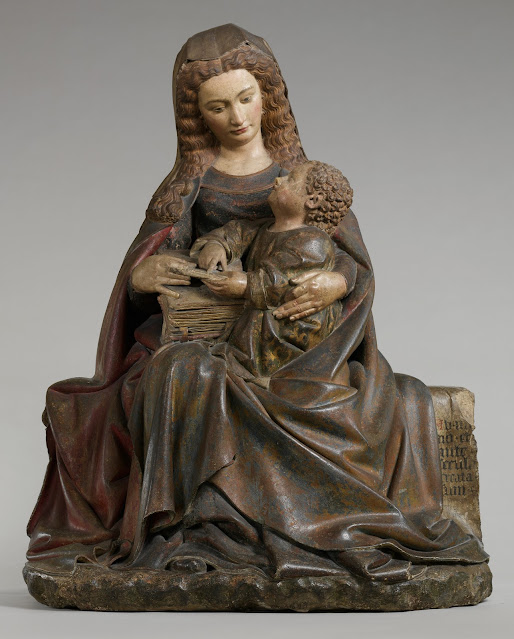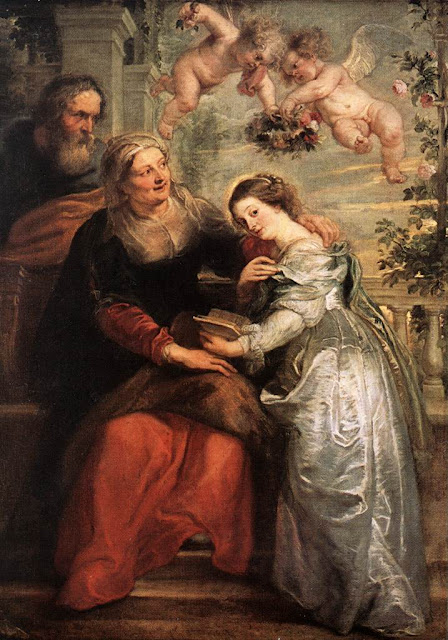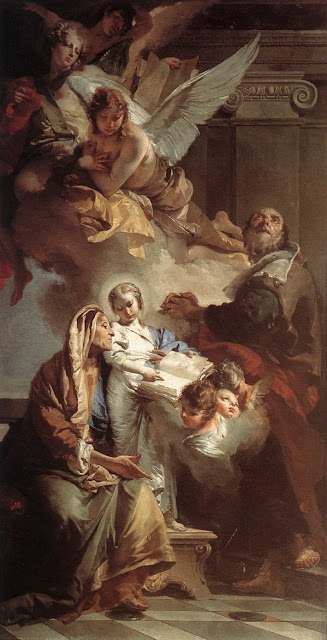 |
| Claus de Werve, The Virgin and Child Dutch, c. 1415-1417 New York, Metropolitan Museum of Art |
One of the most familiar images of Saint Anne is as Mary's teacher. In spite of writings such as the Golden Legend and the tradition based on them, i.e., that Mary spent the years between age 3 and puberty in the temple, there is an equally strong tradition that she spent those years at home, under the instruction of her mother.
From at least the 14th century artists have shown Saint Anne as the teacher of her daughter. That it should be thought necessary that Mary should be literate is interesting in itself. The Gospel of Luke tells us that Jesus read from the Book of Isaiah in the synagogue at Nazareth (Luke 4:16-17). Therefore, it is apparently assumed that Mary can read also. Indeed, she is frequently pictured as teaching the Infant Jesus to read in many works of medieval arts, such as a lovely early 15th-century statue in the Metropolitan Museum collection. If Mary can read, then it is a logical assumption that she was taught to read by her own mother, Saint Anne.
So far, the earliest images of Saint Anne as teacher appear to come from 14th-Century England. Due to the destruction of most English religious art during the Reformation and the later Republican period, the surviving images are few and frequently in bad shape. However, a number of wall paintings have emerged from the layers of whitewash and plaster that covered them and there are occasional survivals elsewhere. For example, the Cluny Museum in Paris owns a painted wooden altar frontal from the parish church of Thetford in Suffolk that is dated to about 1335.
So far, the earliest images of Saint Anne as teacher appear to come from 14th-Century England. Due to the destruction of most English religious art during the Reformation and the later Republican period, the surviving images are few and frequently in bad shape. However, a number of wall paintings have emerged from the layers of whitewash and plaster that covered them and there are occasional survivals elsewhere. For example, the Cluny Museum in Paris owns a painted wooden altar frontal from the parish church of Thetford in Suffolk that is dated to about 1335.
 | |
|
Through the medium of illuminated manuscripts the image of Saint Anne as teacher spread to the Continent. It is found in manuscripts from France and Spain and from the Low Countries, as well as in sculpture.  |
| The Education of the Virgin Spanish, 15th century New York, Metropolitan Museum of Art |
 |
| Jean Bourdichon, The Education of the Virgin From the Prayer Book of Anne of Brittany French (Tours), c. 1492-1495 New York, Pierpont Morgan Library MS M 50, fol. 13r |
 |
| Jean Poyer, The Education of the Virgin From the Hours of Henry VIII France(Tours), ca. 1500 New York, Pierpont Morgan Library MS H 8, fol 186v |
In panel and oil paintings it seems to appear later. Among the most important images are:
Peter Paul Rubens The Education of the Virgin of 1625-1626. Rubens painting influenced many later artists (not included here). On a classically balustraded terrace a charming Mary looks up as if interrupted in her lessons by the appearance of the viewer. Joachim looks on from the left and cherubs circle overhead, bearing a crown of roses.
Peter Paul Rubens The Education of the Virgin of 1625-1626. Rubens painting influenced many later artists (not included here). On a classically balustraded terrace a charming Mary looks up as if interrupted in her lessons by the appearance of the viewer. Joachim looks on from the left and cherubs circle overhead, bearing a crown of roses.
 |
| Peter Paul Rubens, The Education of the Virgin Flemish, c. 1625-1626 Brussels, Musées Royaux des Beaux-Arts |
Georges de la Tour set the scene between Anne and Mary by candlelight in order to play over the smooth surfaces of the figures and their clothing. The resulting image has a kind of grand solemnity.
 | |
|
Jean Jouvenet interpreted the event as a pious scene in which the middle-aged Anne instructs a prayerful Mary, watched over by Joachim and surrounded by other young women who are engaged in needlework, while angels pay close attention.
 |
| Jean Jouvenet, The Education of the Virgin French, 1700 Florence, Galleria degli Ufizzi |
Giovanni Battista Tiepolo interweaves the earthly scene of education into a heavenly one as multiple angels float in on clouds.
 |
| Giovanni Battista Tiepolo, The Education of the Virgin Italian, 1732 Venice, Church of Santa Maria della Consolazione |
Near the end of the 18th century, Jean-Honore Fragonard presented a sweetly peaceful earthly scene in which Mary snuggles up to her mother, as she turns from her book.
There is also a less well-known tradition in painting in which Mary’s education consists, not in learning to read, but in learning to work with the needle or the shuttle. The support for this comes from a portion of the Protoevangelion of James 1 in which Mary is chosen to participate in weaving a new veil for the sanctuary of the temple.
In this tradition St. Anne is also the teacher. However, the number of works appears to be much fewer than the more frequently represented education in reading.
In this fragment of fresco attributed to the Master of the Bambino Vispo, Saint Anne appears to be teaching Mary about sewing.
 |
| Jean-Honore Fragonard, The Education of the Virgin French, 1775 Amiens, Musée de Picardie |
There is also a less well-known tradition in painting in which Mary’s education consists, not in learning to read, but in learning to work with the needle or the shuttle. The support for this comes from a portion of the Protoevangelion of James 1 in which Mary is chosen to participate in weaving a new veil for the sanctuary of the temple.
In this tradition St. Anne is also the teacher. However, the number of works appears to be much fewer than the more frequently represented education in reading.
In this fragment of fresco attributed to the Master of the Bambino Vispo, Saint Anne appears to be teaching Mary about sewing.
 |
| Master of the Bambino Vispo, The Education of the Virgin Italian, 1420s Florance, Church of Santa Croce |
The wing of a diptych by Lucas Cranach in which Anne is shown instructing Mary in weaving. Mary is seated at Anne’s feet working on a small loom. Tiny cherub angels are seen inserting themselves into the action.
 |
| Lucas Cranach, The Education of the Virgin German, c. 1510-1512 Dessau, Althältisches Gemäldegalerie |
A painting by the Pre-Raphaelite painter Dante Gabriel Rosetti, shows a domestic scene in which a very Victorian Mary sits in a veranda with her mother, who is instructing her in embroidery, while Saint Joachim trims some vines.
 |
| Dante Gabriel Rossetti, The Girlhood of Mary English, 1848-1849 London, Tate Gallery |
The scene is so ordinary in appearance that Rosetti added some clues to assist us in interpreting it correctly. He has added an attendant angel, a pot of lilies, martyr’s palms, and a dove in a mandorla that is obviously a reference to the Holy Spirit.
An alternate view of this period of Mary's childhood is given by the 17th-century Spanish painter, Francisco de Zurbaran. Here Mary appears to work alone at her needlework in a prayerful attitude. But, perhaps we are meant to assume the unseen presence of her mother, standing beside us as we observe the holy child at work and prayer.
 |
| Francisco de Zurbaran, The Young Virgin Spanish, c. 1632-1633 New York, Metropolitan Museum of Art |
____________________________________________
1. Protoevangelion of James. Translated by Alexander Walker. From Ante-Nicene Fathers, Vol. 8. Edited by Alexander Roberts, James Donaldson, and A. Cleveland Coxe. (Buffalo, NY: Christian Literature Publishing Co., 1886.) Revised and edited for New Advent by Kevin Knight. @ http://www.newadvent.org/fathers/0847.htm
© M. Duffy, 2011/2012

No comments:
Post a Comment